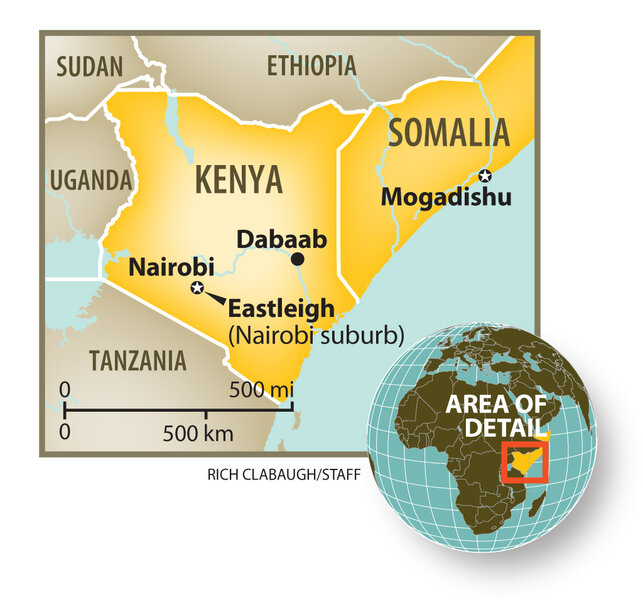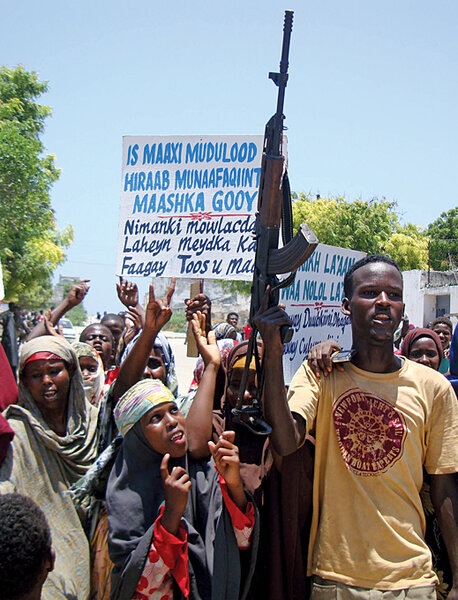Somalia's Al Shabab recruits 'holy warriors' with $400 bonus
Loading...
| Nairobi and Dadaab, Kenya
When Dahir Abdi joined the Somali extremist group Al-Shabab early last year, his motive had more to do with money than with God.
Back home in the Barawa district of southern Somalia, his parents and younger brothers and sisters were living on less than a single meal per day. His mother was too weak to fetch firewood to sell in the market, and too poor to buy the all-covering veil that was now required by Al-Shabab.
So when a recruiter from Al Shabab (whose name means “the youth” in Arabic) gave him $400 and the promise of a regular salary, Dahir joined willingly. He knew that even if he didn’t survive the war, his family would have a better chance to ward off starvation.
By the time Dahir arrived for six months of training at a camp in the densely forested southern coastal town of Ras Kiamboni, it was clear that he was just one of hundreds of young recruits preparing for war. It was clear, too, that deserting from Shabab – which has declared its allegiance to Al Qaeda – would be dangerous.
“When they recruited me, I was told I am going to fight against the African Union troops and against the Transitional Government, which didn’t want an Islamic government,” says Dahir, a talkative young man with a lean frame, who deserted Al Shabab late last year and now lives in hiding. Looking nervously from side to side as he spoke with a reporter in the Dagahley refugee camp in Dadaab, Kenya, he continues. “I was given $400 before I left home, and this I gave to my father and bid my family goodbye. They didn’t want me to leave. My father looked at me in tears and prayed for my safe homecoming.”
When the government of Somalia launches its long-threatened offensive against Al Shabab, it will be young men like Dahir who will be in the front lines, recruited by unscrupulous businessmen, trained by Pakistani, Afghan and Arab experts, and guided by a harsh ideology of jihad promulgated by Al Qaeda and its Islamist followers.
Al Shabab losing its appeal?
Somalia has been largely ungoverned for nearly 20 years, so the appeal of a hard-talking government based on religion has strong appeal in certain quarters. But the testimonies of several Al Shabab deserters interviewed by the Monitor shows that the Islamist militia is built less on a firm ideology – seen by many Somalis to be alien to their understanding of Islam -- than on a combination of monetary lures and threats.
“Everybody hates to die, and everybody wants to go to heaven, but to go to heaven, you have to die: that is what they tell recruits,” says Omar Sharif, a Somali businessman who travels between Mogadishu and Nairobi, and who has family members on both sides of the looming fight. “Shabab is in a decline right now, because people are not happy with what they are doing, but they still have a strong impact on youths inside the country, as well as here in Kenya.”
Yet as long as Somalia remains war-torn, and as long as Somalis remain poor, Shabab will be able to find willing fighters, Mr. Sharif says. “Somalis have a lot of children, and the school system is destroyed, so for many poor families, the madrassas (religious schools) are the only option where children can get at least a basic education. That is where Shabab goes to recruit.”
Virtually unknown four years ago, Al Shabab has rapidly grown to become the strongest military force in Somalia, imposing its own selective interpretation of Islamic law on the southern half of Somalia that is under its control. Al Shabab troops in the very heart of Mogadishu prevent the weak Western-backed government of President Sheikh Sharif Ahmed from extending its authority beyond a few square blocks of the capital, along with the airport and Mogadishu’s seaport.
How strong is Al Shabab?
Estimates of Shabab’s fighting force are quite small, often around 3000 trained fighters with perhaps another 3000 untrained and poorly armed militia members providing logistical support. Mixed into this ragtag army are perhaps 200 foreign fighters – including Afghans, Pakistanis, Arabs, Chechens, and even a few white American converts -- attracted to Al-Shabab by the promise of establishing and defending a “pure” Islamic state, as described by the Prophet Mohammed in the Quran.
Shabab’s strongholds are in the lower third of the country, from the borders of Kenya and Ethiopia and over to the coastal cities of Mogadishu and Kismayo. Shabab deserters say different camps specialize in different types of training. The Al Faruq Brigades, who train at Elberde in the Hiraan region, for instance, trains suicide bombers, as does the Salahudeen unit in the Huriwa district of Mogadishu. The Muaskar Faruq base in Ras Kiamboni specializes in automatic weapons and hand-to-hand combat, while the Eel Aarfid base specializes in training kidnapping skills.
Liban Elmi, a 30-year-old recruit from Nairobi, was jobless and attending a religious school, or madrassa, when he was recruited by an cousin to join Al-Shabab. His cousin’s selling point was simple and direct: Since Mr. Elmi was an orphan with few job prospects, it would be better for him to go up north to his family’s ethnic homeland and fight an Islamic war of liberation than to continue living off his relatives.
“I was desperate, and I was convinced to join because I had nothing else to do,” says Elmi, speaking to a reporter in a private home in Dadaab, close to the refugee camp where he lives. The recruiters told him to change his image, stop shaving, and to start chewing khat, a leaf that has mildly narcotic qualities. In this way, when he disappeared, people would just assume that he had simply gone astray, rather than gone to join a pious religious movement like Al Shabab.
Crossing into Somalia on foot, he and a group of 40 other recruits travelled with a group of Pakistani clerics to the town of Ras Kiamboni. It was there that Elmi joined a fighting unit, and got training in the use of AK-47s and in martial arts. Within weeks of the end of training, Elmi was sent to Mogadishu, where he quickly found himself on the front lines. In heavy fighting last August, a bullet struck Elmi in his right leg, which later had to be amputated by a Shabab doctor. He now hobbles around on an artificial leg that was purchased in Nairobi, but fitted onto him at a Shabab hospital in Mogadishu.
“Now, I’m looking for a way to sustain myself,” he says, bitterly. “I can’t join them again, because even though it’s possible to fix my leg to allow me to fight in combat again, Al Shabab won’t spend the money on me because I’m a foreign fighter. I still resent my cousin, who told me to join.”
Young women are not exempt from Al Shabab recruitment. In the displacement camps on both sides of the Kenyan-Somali border, older women travel from tent to tent, encouraging impoverished families to give their daughters to the holy struggle, or jihad.
“The women tell our parents, ‘Before a man is given a gun, he must be given a woman, so that he can leave something behind,’” says Shamis Abdulaziz, a 25-year-old, who is herself married to an Al-Shabab fighter. “They say, ‘There is no need for you at home. Get married to the mujahideen who are fighting in the fields.’”
Ms. Abdulaziz left her family in Afmadow, a district of southern Somalia, as a willing Shabab recruit. She had been told she would receive training in collecting intelligence, in carrying explosives, and driving supplies from one camp to another. On arrival at the Shabab camp near Afmadow, each girl was told to take off her shoes and put them in a pile. A few minutes later, Shabab fighters walked into the tent and chose a shoe at random. The owner of that shoe became his wife.
“They told us it was our responsibility on behalf of the jihad,” says Abdulaziz proudly. “Now,” she says, “I am one of those women, who convinces young women to marry a young Shabab fighter.”






